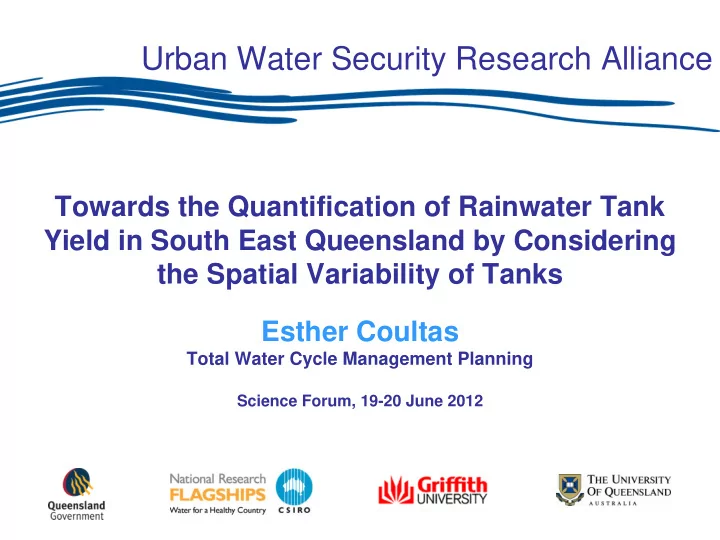

Urban Water Security Research Alliance Towards the Quantification of Rainwater Tank Yield in South East Queensland by Considering the Spatial Variability of Tanks Esther Coultas Total Water Cycle Management Planning Science Forum, 19-20 June 2012
TALK OUTLINE • Outline – Project background – Developing a method to quantify rainwater tank yield at the SEQ scale – Results – Conclusions
Use of household rainwater tanks • Capital cities: 15% in 2007 and 26% in 2010 • Queensland: 18% in 2007 and 43% in 2010 (largest increase of all cities) • 70 kL/year mandatory water savings target for all new houses in Qld • Internally plumbed RWTs contribute to achieving this target Source: ABS, March 2010
Yield of household rainwater tanks • As the uptake of tanks increases, there is a need for quantifying the yield at the SEQ scale – To assess SEQ’s supply and demand balance Source: SEQ Water Strategy, 2010 • Common practice is linear up-scaling of the yield of a tank with average tank characteristics – Can introduce errors because tank yield is not linearly related to tank characteristics
Variability exhibited by rainwater tanks in SEQ • Beal et al . (2012) study based on 2008 water consumption data – 20 kL/h/y to 95 kL/h/y, with a mean of 50 kL/h/y • Chong et al . (2011) study based on 2009 and 2010 consumption data – 24.5 kL/h/y to 88.5 kL/h/y, with a mean of 58.8 kL/h/y
Objectives of the study • To develop a method to account for the spatial variability of supply from rainwater tanks, for the prediction of potable water savings at the SEQ scale • To understand the extent of error caused to tank yield by ignoring the spatial variability
The method: Monte Carlo simulation of rainwater tank yield
Spatial variability exhibited by the input data • Household water consumption in Brisbane (61 SFR households): 30 - 650 L/p/d • Connected roof area (20 houses in SEQ): 37 – 135 m 2 • Tank sizes (106 tanks in Brisbane): 4 – 22 kL
Monte Carlo Simulation: input variables (tank)
Monte Carlo Simulation: input variables (demand) • Sampling from 200 Per capita observed end use break down ‐ Brisbane Irrigation 7.2 l/p/d plausible demand time Bathtub (6%) 1.8 l/p/d Toilet (1%) 22.0 l/p/d series Tap (17%) 22.7 (17%) – Generated by calibrating the Dishwasher 2.3 l/p/d Clothes Washer (2%) Stochastic Demand Model of 35.8 l/p/d Shower (27%) 38.6 l/p/d Duncan and Mitchell (2008) (30%) Total average = 130.4 L/p/d using 61 household end use demands in Brisbane • Tank water is used for toilet, laundry and garden use – About 50% of the total household use
Tank yield for different iterations of Monte Carlo simulation
Monte Carlo simulation on a daily time step 41 kL/h/y 47 kL/h/y (14% overestimation)
Monte Carlo simulation on an hourly time step 46 kL/h/y(14% overestimation) 40 kL/h/y
Comparison with yield estimated from billing data • QWC study: Billing records of 1841 single family residential houses in Brisbane during the period from January 2011 to June 2011 – The sample had 120 houses with internally plumbed rainwater tanks (IPR) and 1721 SFR houses without IPR – Compared the average household consumption of the two samples – The estimated average yield: 39 L/p/d or 37 kL/h/y (considering an occupancy rate of 2.6 p/h) • Our study (stochastic simulation): 40 kL/h/y
Conclusions • Tank sizes, connected roof areas and household end uses vary spatially • We examined the effectiveness of Monte Carlo simulation of tank storage behaviour to represent this variability • Tank yield quantified through Monte Carlo simulation is 40 kL/h/y. This is about 30% of total household use in Brisbane • If the spatial variability of tank and water use characteristics are ignored, the tank yield will be overestimated by 14% (for Brisbane household data) • Work in progress to repeat the analysis for Gold Coast, Sunshine Coast and Ipswich
Urban Water Security Research Alliance Acknowledgements Co-authors - Shiroma Maheepala, Luis Neumann, Cara Beal, Rodney Stewart, Meng Chong and Ashok Sharma Mark Askins,Tad Bagdon, Patricia Hurikino and Phillip Chan of the Queensland Water Commission for providing access to their study, tank data and the valuable advice THANK YOU! www.urbanwateralliance.org.au
Recommend
More recommend